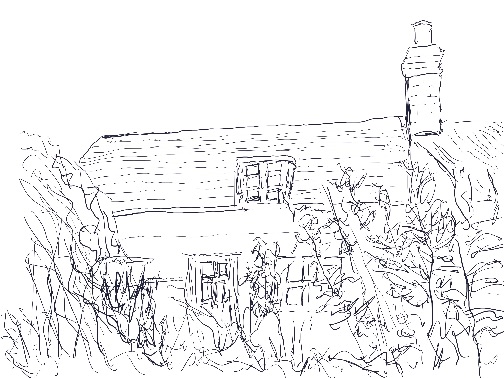Round the outside
I’ve grabbed some time to come visit the place.
Quick skip round the outside. No obvious sign of any break-in, so that’s good. Helps that it’s a long way from anywhere, I guess. And it’s hard to spot if you didn’t already know it was here, hidden in the dip behind that huge great oak-tree and the thick thorn hedge.
Always quiet round here – a deep quiet, you might call it. Nice. And a lot of weird-looking plants all round the house that I don’t recognise at all – but then I’m not much of a gardener, so I probably wouldn’t know them anyway.
A bit of an odd place, I suppose, though that’s not unusual round here. The core is typical enough, a two-up-two-down with upper rooms gabled into the roof and no real attic. At a guess, it’s three centuries old at least, maybe more. Looks it.
As for the rest, well, it’s what farmers here call a ‘good-year house’ – every time you have a good year, you add on another room or annexe, like they’ve done with that weird conservatory out here, that’s a lot newer than the rest. The whole thing is rambling off in all directions, a mish-mash of building-styles and building-materials and god knows what.

And oh joy, it’s all external plumbing – the Great British Innovation that guarantees that everything locks up solid every winter. Clearing a frozen down-pipe when it’s snowing outside is no fun for anyone. At least they’ve had the sense to wrap some of it in some kind of wooden cladding. That might make a difference.
But all of it will need a fair bit of TLC, I’d say. And I wouldn’t mind betting there’ll be a whole load of asbestos and worse hidden away in that lot. Whoever takes it on is going to have a whole heap of pain with that. Glad it’s not us, now.
—
The barns. They’re decrepit, but they always were.
It hasn’t changed around here in fifty years. Memories…
—
It was a small mixed-farm, enough to live on and not much more. But a bit different than most round here. No livestock, no cattle, no sheep, no horses, just arable and orchard.
Never could understand how he ploughed his fields, though. No tractor, no horse, no heavy implements like a harrow or a plough. We never saw him do it. Half-term was always at the wrong season, maybe.
I remember there were those great big logs, lying out lengthways, out in the fields. They’d be somewhere out at the edge, still with some of their roots sticking into the ground, but with leaves and spiky branches, like a giant insect.
And there were those large wooden rack-things, about the size of an old-fashioned wagon, four legs either side, sometimes parked beside a field-gate, sometimes back by the barn. No idea how he moved them around, though, because he had nothing that could do that.
Odd.
I’ve grabbed some time to come visit the place.
Quick skip round the outside. No obvious sign of any break-in, so that’s good. Helps that it’s a long way from anywhere, I guess. And it’s hard to spot if you didn’t already know it was here, hidden in the dip behind that huge great oak-tree and the thick thorn hedge.
Always quiet round here – a deep quiet, you might call it. Nice. And a lot of weird-looking plants all round the house that I don’t recognise at all – but then I’m not much of a gardener, so I probably wouldn’t know them anyway.
A bit of an odd place, I suppose, though that’s not unusual round here. The core is typical enough, a two-up-two-down with upper rooms gabled into the roof and no real attic. At a guess, it’s three centuries old at least, maybe more. Looks it.
As for the rest, well, it’s what farmers here call a ‘good-year house’ – every time you have a good year, you add on another room or annexe, like they’ve done with that weird conservatory out here, that’s a lot newer than the rest. The whole thing is rambling off in all directions, a mish-mash of building-styles and building-materials and god knows what.

And oh joy, it’s all external plumbing – the Great British Innovation that guarantees that everything locks up solid every winter. Clearing a frozen down-pipe when it’s snowing outside is no fun for anyone. At least they’ve had the sense to wrap some of it in some kind of wooden cladding. That might make a difference.
But all of it will need a fair bit of TLC, I’d say. And I wouldn’t mind betting there’ll be a whole load of asbestos and worse hidden away in that lot. Whoever takes it on is going to have a whole heap of pain with that. Glad it’s not us, now.
—
The barns. They’re decrepit, but they always were.
It hasn’t changed around here in fifty years. Memories…
—
It was a small mixed-farm, enough to live on and not much more. But a bit different than most round here. No livestock, no cattle, no sheep, no horses, just arable and orchard.
Never could understand how he ploughed his fields, though. No tractor, no horse, no heavy implements like a harrow or a plough. We never saw him do it. Half-term was always at the wrong season, maybe.
I remember there were those great big logs, lying out lengthways, out in the fields. They’d be somewhere out at the edge, still with some of their roots sticking into the ground, but with leaves and spiky branches, like a giant insect.
And there were those large wooden rack-things, about the size of an old-fashioned wagon, four legs either side, sometimes parked beside a field-gate, sometimes back by the barn. No idea how he moved them around, though, because he had nothing that could do that.
Odd.
Recent Comments